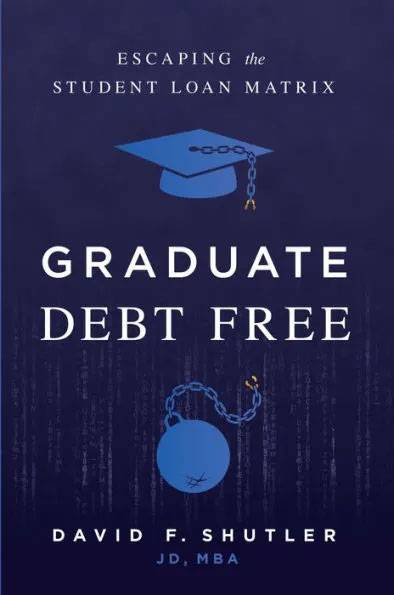College admission season is coming up, and with it, the looming question is: How am I going to finance my education? To most, the answer lies in some combination of savings, financial aid, and—most significantly—loans. Far too often, families dive headlong into debt. As of September 2022, the federal student loan balance was $1.6345 trillion, with some 43.5 million borrowers owing an average of $37,575 in federal debt (and that’s not even including private student loans). Those figures represent a sobering number of college students who are struggling to pay off burdensome loans, a fact that holds grave implications for their future. But you can avoid this in the future.
The loan problem goes beyond students
We refer to all this as a “student” loan problem, but sadly, it’s not only students who are caught in this net. Parents are often trapped in a similar financial bind. After assisting with their young adult’s education, roughly 10% of undergraduate parents face the burden of their own onerous loans, with recent estimates indicating that Parent PLUS Loans exceed an average of $30,000. According to the Federal Reserve Board’s Survey of Consumer Finances, which measures household debt, the average household education loan debt was $40,549.84 in 2019, and it was held by 21.4% of households. That’s a lot of folks owing a whole lot of money.
 One important reason that’s often overlooked in the conversation about financing higher education is that families and students have been conditioned by several flawed assumptions that often shape their decision-making processes. Collectively, I call these assumptions the Student Loan Matrix, and I discuss them in my new book Graduate Debt Free.
One important reason that’s often overlooked in the conversation about financing higher education is that families and students have been conditioned by several flawed assumptions that often shape their decision-making processes. Collectively, I call these assumptions the Student Loan Matrix, and I discuss them in my new book Graduate Debt Free.
Related: What You Need to Know About Taking on Student Loans
What can you do to avoid college debt?
The good news is neither parents nor students have to go into debt to finance a college education. There are numerous financial alternatives that most families aren’t aware of or don’t consider that can significantly reduce—or even eliminate—student debt. So before you sign off on that loan, make sure you have fully considered all your options, including my top four loan-free ways to finance college:
1. Education “à la carte”
Many fast-food franchises offer competitive pay, flexible hours, and, most importantly, college scholarship opportunities. One advantage to this route is it provides money toward college while also gaining experience and seniority in your job. McDonald’s, Taco Bell, Chipotle, In-N-Out, Chick-fil-A, Starbucks, and Papa John’s are just a few of the chains that offer various amounts of scholarship money to qualifying employees. Some offer as much as $5,250 per year toward college costs.
2. Big-box business scholarships
If you’re not fundamentally a fan of serving fried food for many hours each week, consider getting a job at a big-box business that has scholarship opportunities available to employees instead. Companies such as Walmart and Target offer scholarships for full- and part-time employees. Industrious students can fund their educational journey and begin earning valuable work experience by investing their time at these companies for a few years early on.
Related: How You Could Go to College for Free on a Big Company's Dime
3. Other employer-provided education assistance benefits
Provided under IRS Code Section 127, some level of tuition reimbursement is also offered by a plethora of other employers, from restaurants and grocery stores to gas companies, banks, and airlines. These programs are often less generous than those focused on scholarships but can be valuable nonetheless. A great place to start looking is Hip2Save’s list of over 40 companies that offer their employees some level of tuition reimbursement. At job interviews, inquire if they offer any Section 127 benefits. Bonus: It will impress the interviewer!
4. Military service
Many aspiring college students find they can fund their education through opportunities with the US Armed Forces. Service members can earn college credits through technical military training courses and apply for tuition assistance that can vastly reduce (up to 75%) their college price tag. College scholarships through the Reserve Officer Training Corps (ROTC) program offer full and partial coverage of college costs and can lead to a commission in the Armed Forces. Regular enlistees who serve continuously for 90 days may be eligible for the Post–9/11 GI Bill, which covers the full cost of in-state tuition and fees at four-year public universities and offers allowances for housing and book fees. Additionally, the Yellow Ribbon Program can help pay for higher out-of-state, private, international, or graduate school tuition and fees that the bill doesn’t cover.
Related: College Options for Students Interested in the Military
All families would be wise to consider not only these and other alternatives to the risky endeavor of taking on debt but also think beyond the matrix that leads far too many Americans down the path of groupthink about college and the financial choices involved. Branch out, explore your options, and save yourself some financial stress!
Scholarships are a great way to pay for college debt-free. Start searching for awards you’re eligible for using our Scholarship Search tool!






